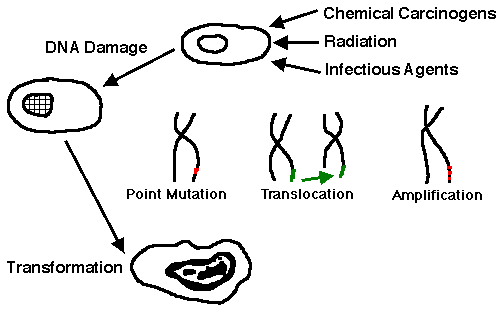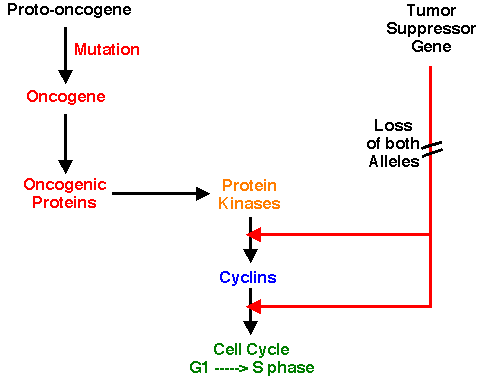Neoplasia and Genetics
Many neoplasms may be directly linked to genetic abnormalities. Most of the genetic alterations in human neoplasms are acquired somatic cell mutations, while a minority are linked to inherited genetic problems.
A neoplasm is an uncontrolled growth of cells, leading to a mass (tumor). If the process is indolent and the mass remains localized, then a benign neoplasm is the result. If the neoplasm acts in a more aggressive fashion, then it is called malignant.
Neoplasms are the result of the loss of control of cell growth. There are a host of complex genetic controls on cellular growth. Some of these genetic factors are most important during embryogenesis and are then turned off. Other continue through life. Control is often achieved via activation or suppression of protein kinases.
The diagram below illustrates how genetic alterations may occur:

Genetic damage with DNA alterations leads to point mutations of genes, translocations of genetic material between chromosomes, and gene reduplication with amplification. These alterations transform proto-oncogenes into oncogenes. The proto-oncogenes may play a role in growth promotion and regulation in normal cells, perhaps in embryogenesis, but are typically "turned off" in adults. They are "turned on" by transformation. Likwise, mutations may render tumor suppressor genes inactive, leading to loss of cell growth control.
The fundamental concept of neoplasia is that the neoplasm arises from a single clone of cells, so that neoplasms are monoclonal. The classic experiment that proved this was the demonstration of two glucose 6 phosphate dehydrogenase (G6PD) alleles in normal cells on an individual and only a single allele in a neoplasm in that individual.
Cellular growth can be compared to driving an automobile: you have an accelerator to increase speed (growth), you have a brake to decrease speed (growth), and you have gas in the tank to keep going (growing).
Accelerators of growth are known as oncogenes or proto-oncogenes. If they are turned on, then growth is stimulated. One of the more common oncogenes turned on in a neoplastic process is the ras oncogene, which increases growth factor signal transduction, because the oncogene lacks the GTPase activity that limits GTP induction of cytoplasmic kinases that drive cell growth
Brakes on growth are known as suppressors, or tumor suppressors. They function to inhibit cellular proliferation. An example of a tumor suppressor is the retinoblastoma (Rb) gene. If both alleles are lost, then growth control is lost. This illustrates the so-called "two hit" mechanism. A person who inherits one bad allele has one hit already, and it is only a matter of time until a second hit occurs in a cell, leading to neoplasia.
The gas tank consists of genes that allow continuing growth. An example of this is the gene that controls telomerase, which is needed to repair the ends of chromosomes following cell division. Normal cells do not express this enzyme and undergo limited cell divisions, while tumor cells can continue to divide and grow. Tumors often secrete angiogenesis factors that help to create a vascular supply that supports continued growth. Normal cells typically do not express these genes.
The pathways of control of cell growth are illustrated in the diagram below:

In the case of inherited cancer syndromes, an affected person is born having an abnormal allele. This does not guarantee that a cancer will occur, but increases the risk substantially. Often, the cancer that develops is similar to a cancer that occurs much more frequently in the general population of persons without an inherited mutation. In general, a person who has a "cancer gene" is more likely to develop the cancer at a younger age than persons without the gene, to have multiple cancers, or to have a family history of a particular cancer.
As an example, the BRCA1 gene involves a mutation in a gene encoding for a protein that is involved with repair of double-stranded DNA breaks. Since the gene is large, there have been many different mutations found in families, but in all of them the abnormal protein has a loss of function that leads to problems in DNA repair that increase the risk for breast and ovarian cancer.
Another example is the APC (adenomatous polyposis coli) gene. The APC gene encodes for a protein that probably acts as a tumor suppressor. Inheritance of an abnormal APC gene means that, if loss of the normal allele occurs, which often happens early in life, then loss of growth control leads to the formation of many adenomas in the colon. However, colon cancer typically occurs after a string of mutations has occurred. A person inheriting the abnormal APC gene is at greater risk for this sequence to occur.


